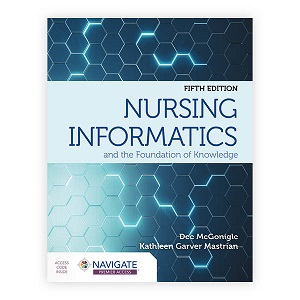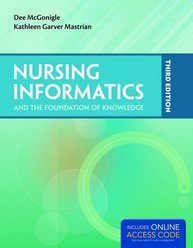Nursing Informatics and the Foundation of Knowledge
Chapter 3 by © 2009-2022 ~ June Kaminski, MSN PhD(c)
 June wrote Chapter Three, "Computer Science and the Foundation of Knowledge Model" for the textbook, Nursing Informatics and the Foundation of Knowledge which was first published by Jones and Bartlett in 2009, the fifth edition came out in 2022.
June wrote Chapter Three, "Computer Science and the Foundation of Knowledge Model" for the textbook, Nursing Informatics and the Foundation of Knowledge which was first published by Jones and Bartlett in 2009, the fifth edition came out in 2022.
First edition: ISBN-13: 9780763753283 - Paperback - 499 Pages © 2009
Second edition: ISBN-13: 9781449631741 - Paperback - 500 Pages © 2012
Third edition: ISBN-13: 9781284043518 - Paperback - 586 Pages © 2015
Fourth edition: ISBN-13: 978-1284121247 - Paperback - 606 Pages © 2017
Fifth edition: ISBN: 9781284220469 - Paperback - 606 Pages © 2022
This textbook was edited by Dr. Dee McGonigle and Dr. Kathleen Mastrian, both faculty at Penn State University. Dee is the former Editor in Chief of the Online Journal of Nursing Informatics. The list of authors is like a who's who of nursing informatics, offering a very usable and invaluable tool for either teaching informatics or for personal professional development reading. The companion book site comes complete with student and instructor resources, including powerpoints, flashcards, crosswords, test banks, pod casts, instructors manual and tools and informatics updates. Click here to visit the Book site.
Nursing Informatics and the Foundation of Knowledge covers the history of healthcare informatics, current issues, basic informatics concepts, and health information management applications. With comprehensive introductory chapters that explain the core sciences of nursing informatics, students will understand Information Systems and incorporate their own knowledge for further comprehension. Based on The Foundation of Knowledge Model? 2007, this text explains how nursing informatics relates to knowledge acquisition, knowledge processing, knowledge generation, knowledge dissemination and feedback, all of which build the science of nursing.
Point to Ponder....
"Since the beginning of the profession, nurses have applied their ingenuity, resourcefulness, and professional awareness of what works to adapt technology and objects to support nursing care, usually with the intent to promote efficiency but also client comfort and healing."
- June Kaminski
EXCERPT FROM CHAPTER THREE
Looking to the Future
 The coming trends in wearable technology, smaller and faster hand held and portable computer systems, and high quality voice-activated inventions will further facilitate the utility of computers in nursing practice and professional development. The field of computer science will continue to contribute to the evolving art and science of nursing informatics. New trends promise to bring wide-sweeping and hopefully, positive changes to the practice of nursing. Computers and other technologies have the potential to support a more client-oriented health care system where clients truly become active participants in their own health care planning and decisions. Mobile health technology, tele-nursing, sophisticated electronic health records, and next generation technology are predicted to contribute to high quality nursing care and consultation within health care settings, including patients' homes and communities.
The coming trends in wearable technology, smaller and faster hand held and portable computer systems, and high quality voice-activated inventions will further facilitate the utility of computers in nursing practice and professional development. The field of computer science will continue to contribute to the evolving art and science of nursing informatics. New trends promise to bring wide-sweeping and hopefully, positive changes to the practice of nursing. Computers and other technologies have the potential to support a more client-oriented health care system where clients truly become active participants in their own health care planning and decisions. Mobile health technology, tele-nursing, sophisticated electronic health records, and next generation technology are predicted to contribute to high quality nursing care and consultation within health care settings, including patients' homes and communities.
Computers will become more powerful yet more compact which will contribute to the development of several technological initiatives which are still in their infancy at this point. The following include some of these initiatives.
- Voice Activated Communicators are already being developed in Silicon Valley by companies like Vocera Communications Inc. These new technologies will permit nurses and other health care professionals to use wireless, hands-free devices to communicate with each other, and to record data. This can promote this technology which promises to become a user-friendly and cost-effective way to increase clinical productivity.
- Game and Simulation Technology promises to offer realistic, innovative ways to teach nursing content in general, including nursing informatics concepts and skills. The same technology that powers video games can be used to create dynamic educational interfaces to help student nurses learn about pathophysiology, care guidelines, medication usage, and a host of other topics. These applications can also be very valuable for client education and health promotion materials. The 'serious games' industry is just beginning to develop. Video game producers are now looking beyond mere entertainment to address public and private policy, management, and leadership issues and topics, including health care related ones. For instance, the Games for Health Project, initiated by the Robert Wood Johnson Foundation is working on developing best practices to support innovation in health care training, messaging, and illness management.
- Virtual Reality (VR) is another technological breakthrough that will become common in nursing education and professional development. Basically, VR is a three dimensional computer generated "world" where a person (with the right equipment) can move about and interact as if he or she were actually in the visualized location. The person's senses are immersed in this VR world using special gadgetry such as head-mounted displays, DataGloves, joysticks, and other hand tools. The equipment and special technology provides a sense of presence that is lacking in multimedia and other complex programs.
- Mobile Devices will be used more by nurses both at the point-of-care and in planning, documenting, interacting with the health care team, and in research. There are strong indicators that nursing is ready to move quickly to adopt this new technology and utilize it to its full potential at the point-of-care. We anticipate the rate of adoption for mobile information systems within nursing to be rapid, and it will ultimately equal and perhaps exceed that of physicians. Mobile Nursing Informatics will be at the core of nursing in the 21st century. Ready access to data and analytical tools will fundamentally change the way practitioners of the health sciences conduct research, and approach and solve problems. (Suszka-Hildebrandt, 2000, p.3).
These predicted innovations are only some of the many computer and technological applications being developed. As nurses gain proficiency in capitalizing on the creative, time-saving, and interactive capabilities emerging from information technology research, the field of nursing informatics will grow in similar proportions.















